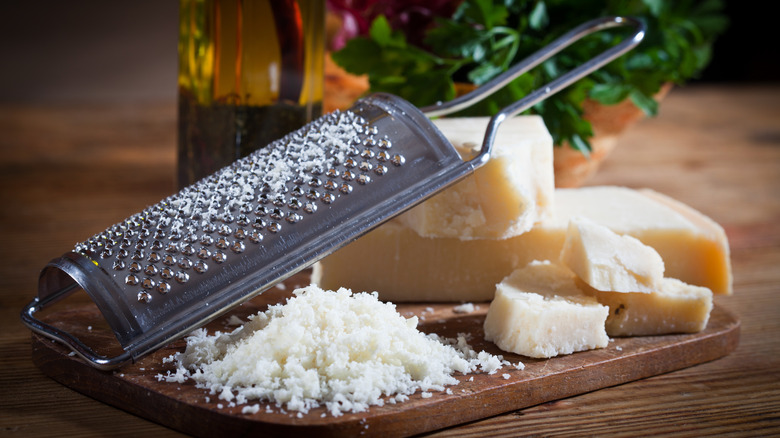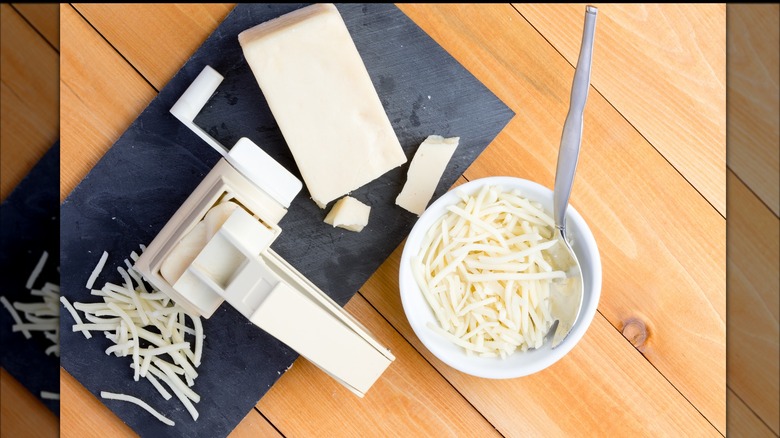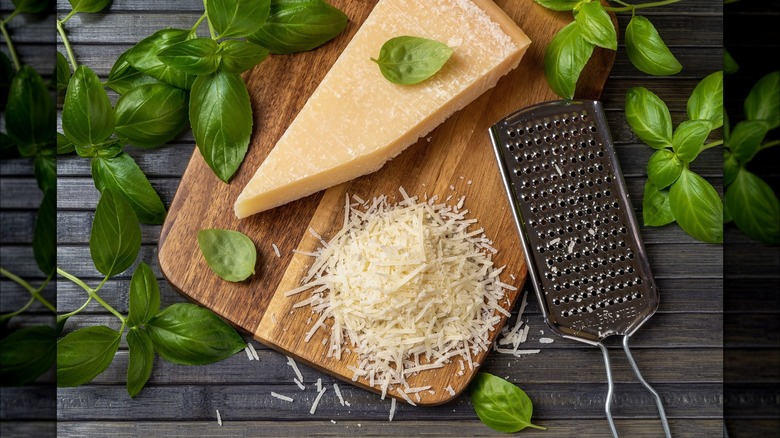The Safety Measure To Take The Next Time You Use A Cheese Grater
Have you ever cut yourself with a cheese grater? Or are you fearful of such an event? Well, we've got you covered — literally. We have just the safety measure to turn you into a confident cook, and it involves protecting that precious skin.
To keep yourself safe, wear a silicone potholder while grating cheese. It has enough flexibility to hold cheese yet is thick enough to protect fingers should they come too close to the blades. When you're ready to shred, place the grater on a sturdy surface. Cover your dominant hand with the silicone potholder and hold the grater's handle with the other. While stabilizing the grater, glide the cheese downward against the blades slowly and carefully. Bring your cheese back to the top and repeat as many times as necessary.
The process sounds simple enough, but we've got even more tricks up our sleeve. Don't have a silicone potholder? We've got alternatives. Is your cheese too soft or hard to grate? We've got shredding hacks. We also have a secret to safely shredding every last inch of that cheese block. After all, nobody wants to be left with a cheese stub (or a finger stub for that matter). So get ready to become a grating pro — and excuse all our cheesy puns along the way.
Other options if you don't have a silicone potholder
If you don't have a silicone potholder handy, no worries! There are similar items lying around your home that work just as well. Latex cleaning gloves are suitable to wear while grating. However, make sure you've washed your glove thoroughly beforehand to remove any lingering cleaning products. A bleach aftertaste might not go down so well at a family dinner.
Alternatively, a regular potholder could get the job done. But depending on the material, it may not have a strong grip like silicone varieties. So make sure you have a solid hold on the cheese before you get grating. If you're happy to invest in kitchenware, cut-resistant gloves work surprisingly well. And lastly, silicone thimbles can also protect your fingertips from the shredding blades. So if your sewing supplies are better stocked than your kitchen, this might be preferable.
Another way to protect your hands is by using a less conventional cheese grater. With a rotary cheese grater, you can avoid holding the cheese altogether. You simply place the cheese at the top, press down with the handlebar, and spin the lever. An electric grater is even easier, although more expensive. But if you're on a budget, you can opt for a plastic grater. This is less likely to cause damage should it come in contact with your fingers. However, they're also known to be less effective overall.
More ways to stay safe while using a cheese grater
Are you using a traditional grater like the one-surface or box-style? If so, there are even more ways to protect yourself. For starters, we suggest placing the grater on a cutting board or parchment paper rather than a plate. These catch the cheese but are less likely to wobble or shift under pressure.
When it comes to shredding, the consistency of cheese is also important. When cheese has the right texture, it'll provide the right resistance against the blades. You don't want to fight with hard cheese or end up with a goopy pile of soft cheese. To avoid this, pop soft cheeses in the freezer for 15-30 minutes to create a firmer texture. To soften hard cheese, wrap it in a damp paper towel and store it in your fridge's cheese drawer for at least an hour.
Hopefully, you've already picked up some grate hacks for shredding cheese. However, we've saved the best for last. Once you reach the very end of that cheese block, use the palm of your hand (with the potholder still on) to finish the cheese. Your hands will be safe, and there will be no cheese left behind. It's a win-win because when it comes to food as delicious as cheese, you'll want to enjoy every last inch.


